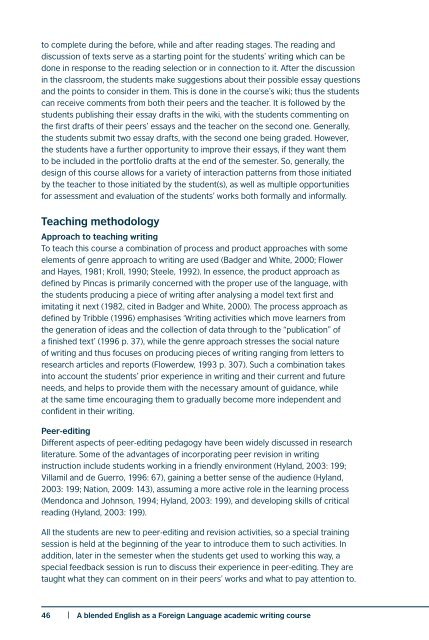Blended Learning in English Language Teaching: Course Design and Implementation
Blended Learning in English Language Teaching: Course Design and Implementation
Blended Learning in English Language Teaching: Course Design and Implementation
Create successful ePaper yourself
Turn your PDF publications into a flip-book with our unique Google optimized e-Paper software.
to complete dur<strong>in</strong>g the before, while <strong>and</strong> after read<strong>in</strong>g stages. The read<strong>in</strong>g <strong>and</strong><br />
discussion of texts serve as a start<strong>in</strong>g po<strong>in</strong>t for the students’ writ<strong>in</strong>g which can be<br />
done <strong>in</strong> response to the read<strong>in</strong>g selection or <strong>in</strong> connection to it. After the discussion<br />
<strong>in</strong> the classroom, the students make suggestions about their possible essay questions<br />
<strong>and</strong> the po<strong>in</strong>ts to consider <strong>in</strong> them. This is done <strong>in</strong> the course’s wiki; thus the students<br />
can receive comments from both their peers <strong>and</strong> the teacher. It is followed by the<br />
students publish<strong>in</strong>g their essay drafts <strong>in</strong> the wiki, with the students comment<strong>in</strong>g on<br />
the first drafts of their peers’ essays <strong>and</strong> the teacher on the second one. Generally,<br />
the students submit two essay drafts, with the second one be<strong>in</strong>g graded. However,<br />
the students have a further opportunity to improve their essays, if they want them<br />
to be <strong>in</strong>cluded <strong>in</strong> the portfolio drafts at the end of the semester. So, generally, the<br />
design of this course allows for a variety of <strong>in</strong>teraction patterns from those <strong>in</strong>itiated<br />
by the teacher to those <strong>in</strong>itiated by the student(s), as well as multiple opportunities<br />
for assessment <strong>and</strong> evaluation of the students’ works both formally <strong>and</strong> <strong>in</strong>formally.<br />
Teach<strong>in</strong>g methodology<br />
Approach to teach<strong>in</strong>g writ<strong>in</strong>g<br />
To teach this course a comb<strong>in</strong>ation of process <strong>and</strong> product approaches with some<br />
elements of genre approach to writ<strong>in</strong>g are used (Badger <strong>and</strong> White, 2000; Flower<br />
<strong>and</strong> Hayes, 1981; Kroll, 1990; Steele, 1992). In essence, the product approach as<br />
def<strong>in</strong>ed by P<strong>in</strong>cas is primarily concerned with the proper use of the language, with<br />
the students produc<strong>in</strong>g a piece of writ<strong>in</strong>g after analys<strong>in</strong>g a model text first <strong>and</strong><br />
imitat<strong>in</strong>g it next (1982, cited <strong>in</strong> Badger <strong>and</strong> White, 2000). The process approach as<br />
def<strong>in</strong>ed by Tribble (1996) emphasises ‘Writ<strong>in</strong>g activities which move learners from<br />
the generation of ideas <strong>and</strong> the collection of data through to the “publication” of<br />
a f<strong>in</strong>ished text’ (1996 p. 37), while the genre approach stresses the social nature<br />
of writ<strong>in</strong>g <strong>and</strong> thus focuses on produc<strong>in</strong>g pieces of writ<strong>in</strong>g rang<strong>in</strong>g from letters to<br />
research articles <strong>and</strong> reports (Flowerdew, 1993 p. 307). Such a comb<strong>in</strong>ation takes<br />
<strong>in</strong>to account the students’ prior experience <strong>in</strong> writ<strong>in</strong>g <strong>and</strong> their current <strong>and</strong> future<br />
needs, <strong>and</strong> helps to provide them with the necessary amount of guidance, while<br />
at the same time encourag<strong>in</strong>g them to gradually become more <strong>in</strong>dependent <strong>and</strong><br />
confident <strong>in</strong> their writ<strong>in</strong>g.<br />
Peer-edit<strong>in</strong>g<br />
Different aspects of peer-edit<strong>in</strong>g pedagogy have been widely discussed <strong>in</strong> research<br />
literature. Some of the advantages of <strong>in</strong>corporat<strong>in</strong>g peer revision <strong>in</strong> writ<strong>in</strong>g<br />
<strong>in</strong>struction <strong>in</strong>clude students work<strong>in</strong>g <strong>in</strong> a friendly environment (Hyl<strong>and</strong>, 2003: 199;<br />
Villamil <strong>and</strong> de Guerro, 1996: 67), ga<strong>in</strong><strong>in</strong>g a better sense of the audience (Hyl<strong>and</strong>,<br />
2003: 199; Nation, 2009: 143), assum<strong>in</strong>g a more active role <strong>in</strong> the learn<strong>in</strong>g process<br />
(Mendonca <strong>and</strong> Johnson, 1994; Hyl<strong>and</strong>, 2003: 199), <strong>and</strong> develop<strong>in</strong>g skills of critical<br />
read<strong>in</strong>g (Hyl<strong>and</strong>, 2003: 199).<br />
All the students are new to peer-edit<strong>in</strong>g <strong>and</strong> revision activities, so a special tra<strong>in</strong><strong>in</strong>g<br />
session is held at the beg<strong>in</strong>n<strong>in</strong>g of the year to <strong>in</strong>troduce them to such activities. In<br />
addition, later <strong>in</strong> the semester when the students get used to work<strong>in</strong>g this way, a<br />
special feedback session is run to discuss their experience <strong>in</strong> peer-edit<strong>in</strong>g. They are<br />
taught what they can comment on <strong>in</strong> their peers’ works <strong>and</strong> what to pay attention to.<br />
46 | A blended <strong>English</strong> as a Foreign <strong>Language</strong> academic writ<strong>in</strong>g course


